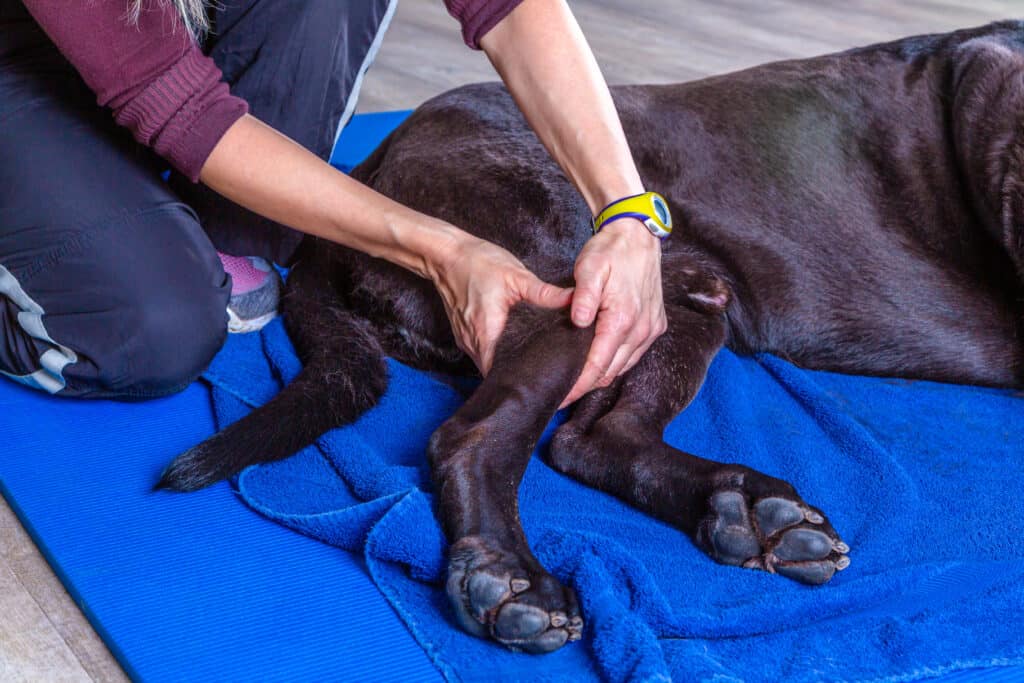An ACL injury is known as an athlete’s worst nightmare. A torn ACL can be a devastating diagnosis for many, as it requires both surgery and extensive physical therapy to mend. While many people are aware of the dreaded torn ACL in humans, you may be surprised to learn that dogs can suffer from a similar injury themselves.
The connective tissues that support the canine knee can suffer from a variety of strains and tears, many of which will require veterinary care and rehabilitation to heal. Fast action is essential when it comes to helping our canine friends recover, and we can only offer them swift care when we are aware of the injury symptoms to lookout for. To make sure you can spot a torn ACL in your dog, let’s discuss the most common signs of a torn ACL in dogs below!
Do Dogs Have an ACL?
Before we discuss the details surrounding this serious knee injury in dogs, it’s important to realize that dogs do not actually have an anterior cruciate ligament (ACL) like humans do. Dogs instead have a cranial cruciate ligament (CCL), and this ligament plays a similar role to the human ACL in regard to the function and support of the canine knee.
Many vets will use the term ACL when describing the injury to pet owners, as this is a way to help everyone understand the impact of the injury their dog is experiencing. While you may hear a CCL injury in dogs referred to as an ACL tear, just know that the ligament in question is actually the cranial cruciate ligament.
Can Dogs Tear Their ACL (CCL)?
Yes, unfortunately dogs can tear their CCL in a variety of ways. A torn CCL in dogs is just as life altering as it is in humans, as this injury will lead to severe pain that impacts their quality of life. There are levels of severity to a CCL injury in dogs, with these complications ranging from ligament strains to complete tears. Similar to an ACL injury in people, there are different treatment options based on how severe their injury is.

Some dogs with an ACL injury will require surgery and physical therapy to regain full function of their knee.
©msgrafixx/Shutterstock.com
What Causes a Torn ACL in Dogs?
If you think your dog may have torn their CCL, you may be wondering how this injury could have occurred. While every situation will vary, there are a few common scenarios that are known to put a strain on the cranial cruciate ligament in dogs.
Some of the most common causes of a torn CCL in dogs include:
- Sudden twisting injuries of the knee, occurring most often when a dog is running and suddenly changes direction
- Jumping off a high surface and landing in a way that puts stress on the knee
- Stepping in a hole or uneven surface while running
- Deterioration of the ligament over time due to arthritis in the knee joint, years of strenuous exercise, and even obesity
- Improper breeding that has led to growth complications
The above scenarios are the most common causes of a torn CCL in dogs, but a knee injury can occur for a variety of reasons. No matter how your dog injures their CCL, it will lead to significant discomfort that will need to be addressed by your veterinarian.

Jumping off a high surface and sudden twisting are common causes of a torn CCL in dogs.
©Skumer/Shutterstock.com
Is a Torn ACL More Common in Certain Dog Breeds?
Any type of dog can experience the injuries or predispositions we mentioned above, but it does appear that certain dog breeds are more at risk of injuring their CCL. Knowing that your dog is high risk for a CCL tear can help you be on the lookout for symptoms, as well as trying your best to limit any risk factors in their future.
Not only does breed appear to play a role, but the size and muscle mass of the dog tends to put much more stress on the knee joints and ligaments. Due to this, you will see that each of the dogs on our at risk list are large breed canine friends.
Some of the dog breeds that are most prone to CCL tears include:
- Golden Retrievers
- Labrador Retrievers
- Mastiffs
- Rottweilers
- Saint Bernards
- Akitas
- Pit Bulls
- Newfoundlands
Having one of the breeds above does not mean that your pup will automatically experience a CCL injury throughout their life, but it simply means you should keep an eye out for any troubling symptoms. We also suggest trying your best to keep your high risk dog at a healthy weight over the years, as this can help to prevent painful joint disease and secondary ligament tears because of it.

Golden Retrievers are one of the dog breeds that are most prone to CCL tears.
©Tanya Consaul Photography/Shutterstock.com
What are the Symptoms of a Torn ACL in Dogs?
Now that you have a better understanding of what a cranial cruciate ligament is and how it is damaged in dogs, it’s time to break down the most common symptoms of this painful injury in our canine friends. Being aware of the symptoms of a CCL tear in dogs can help you identify any signs of immediate pain in your pup, as well as letting you know that it is time to pay your veterinarian a visit.
Some of the most common signs of a cranial cruciate ligament tear in dogs include:
- Sudden limping, ranging from mild limping to inability to put any weight on the leg
- A sudden cry out or yelp from your dog while exercising
- Toe touching or only being able to put a small amount of weight on the leg
- Swelling of the knee, often suddenly
- Guarding their limb or appearing fearful to have the leg touched
- Appearing disinterested in exercise or activities they typically enjoy
- Sitting with their leg straight out instead of curling it under them as usual
- Hearing clicks coming from the limb when they are in motion
- Thickening of the affected knee joint
It’s important to keep in mind that CCL injuries in dogs can range from minor strains to complete tears, so this means that the symptoms will range in severity from dog to dog. Even if your little one is just experiencing a mild version of the symptoms we discussed above, we still suggest having them seen by your veterinarian. A minor strain on the CCL can also progress into a full tear if the dog is not receiving proper rest and therapy for the injury, so you always want to be safe and get veterinary input in these situations.

Being aware of the symptoms of a CCL tear in dogs can help you identify any signs of immediate pain.
©Aleksandr Finch/Shutterstock.com
What Should I Do If I Think My Dog Tore Their ACL?
From the moment you notice any sign of leg discomfort in your canine friend, we always suggest trying to limit their activity immediately and reaching out to your vet’s office. Limiting their activity can prevent any further injury until you get a diagnosis from your vet, especially if this leg injury does involve the CCL. Once your pup has a proper assessment from your veterinary team, they can determine the best plan of action moving forward.
CCL injuries can range in severity, so this means that their treatment options will range as well. While some dogs will recover with the help of an ACL brace for dogs, others will require surgery and physical therapy to regain full function of their knee. Your vet is the only one that knows the details of your dog’s injury, so we suggest trusting their guidance and moving forward with their recommended treatment plan.
- Features a lateral aluminum splint
- Works to stabilize the knee and reduce movement
- Offers an ergonomic design
- Constructed from neoprene to help keep dogs comfortable
- Available in nine different sizes (mini to XXL) for both left and right legs
- Provides support and stability to knee joint
- Helps relieve pain
- Speeds up recovery
- Brace has 10 spring side stabilizers
- 7 sizes to choose from
- Improves stability and balance
- Offers superior comfort
- Helps to reduce pain caused by cruciate ligament injuries
- Enables faster recovery
- Available in eight different sizes ranging from XXX-small to XX-large
- Choose a right- or left-sided brace depending on which knee needs support
- Size guide to ensure a proper fit for your pup.
Final Thoughts
ACL injuries in dogs are just as serious as they are in humans. It’s important to have your pup assessed by a vet from the moment you fear they might have injured their knee, as this can help them begin a proper treatment plan that will prevent further progression of the injury. Once you review the symptoms of a CCL tear in dogs that we discussed above, you can jump into action immediately if your canine companion ever falls victim to a CCL tear.
Up Next
- Best ACL Braces For Dogs
- The 6 Best Joint Supplements for Dogs
- Torn ACLs in Dogs: What To Do And How to Fix
The photo featured at the top of this post is © Brian Goodman/Shutterstock.com
Ready to discover the top 10 cutest dog breeds in the entire world?
How about the fastest dogs, the largest dogs and those that are -- quite frankly -- just the kindest dogs on the planet? Each day, AZ Animals sends out lists just like this to our thousands of email subscribers. And the best part? It's FREE. Join today by entering your email below.
Sources
- VCA animal hospitals, Available here: https://vcahospitals.com/know-your-pet/cruciate-ligament-rupture-in-dogs
- American College of Veterinary Surgeons, Available here: https://www.acvs.org/small-animal/cranial-cruciate-ligament-disease
Thank you for reading! Have some feedback for us? Contact the AZ Animals editorial team.










